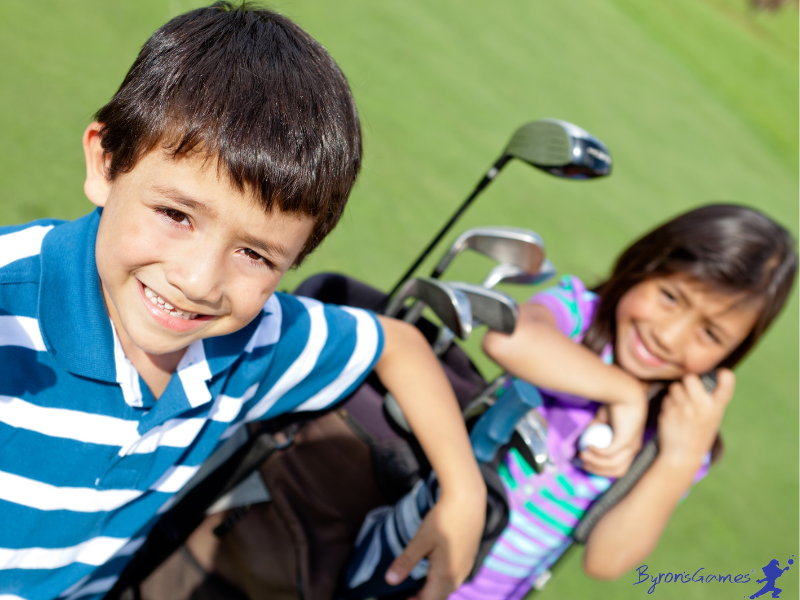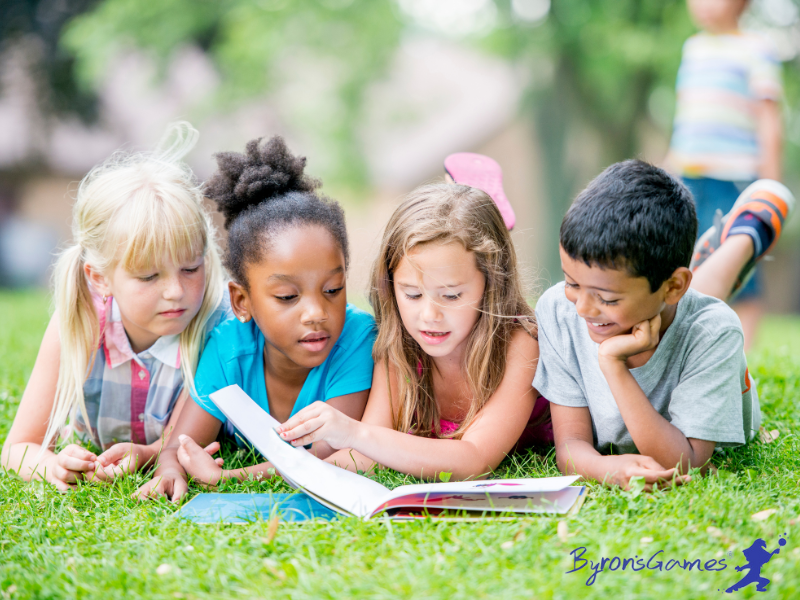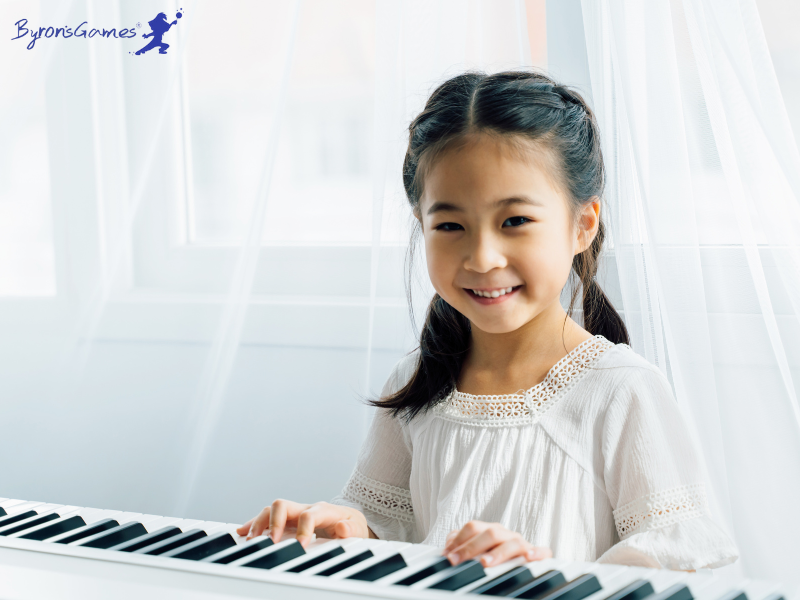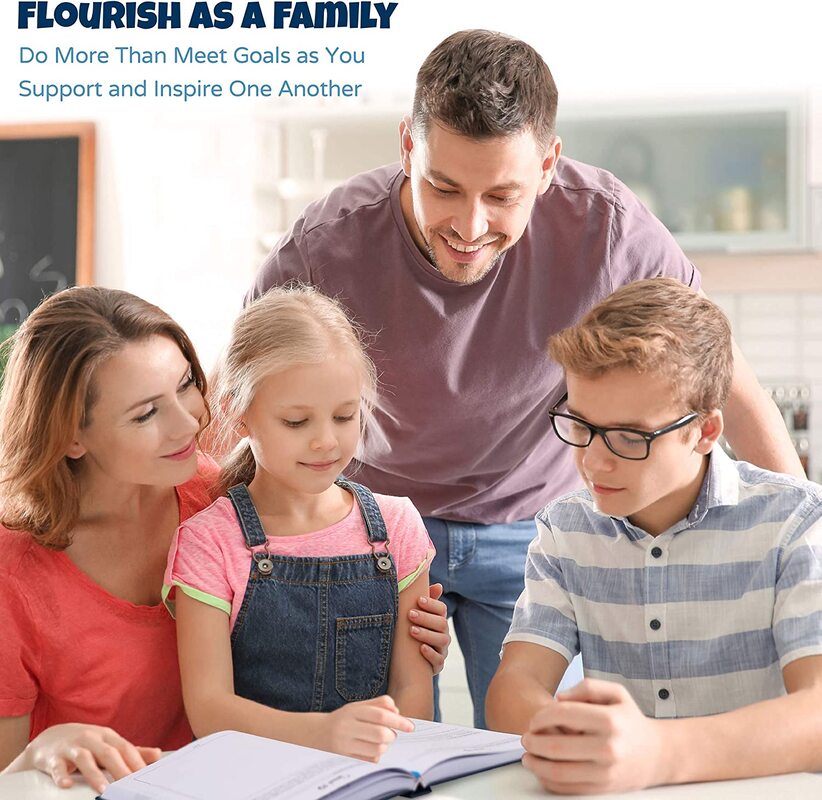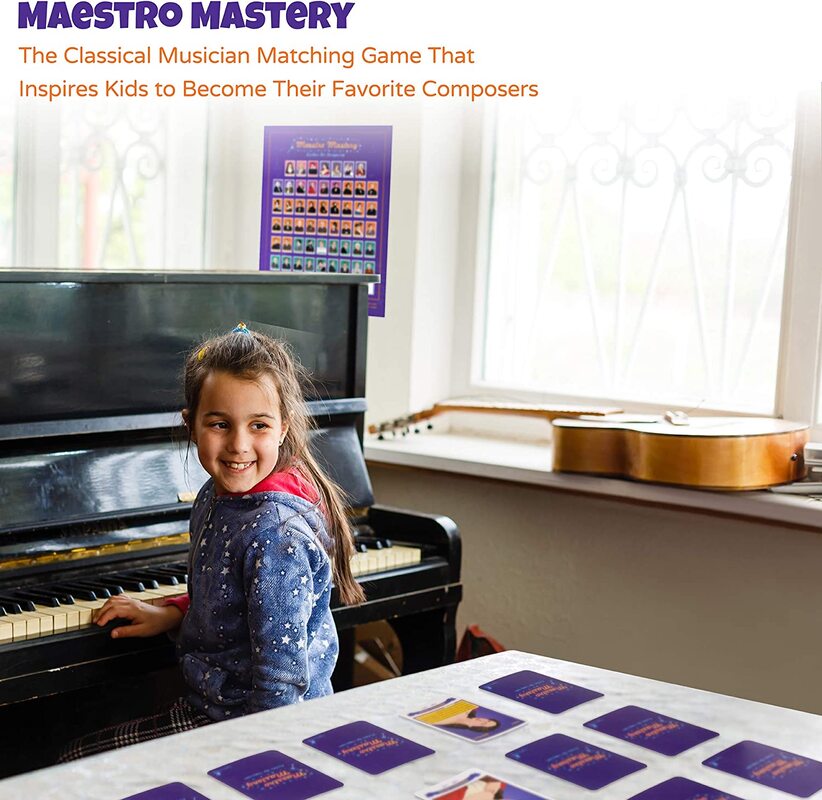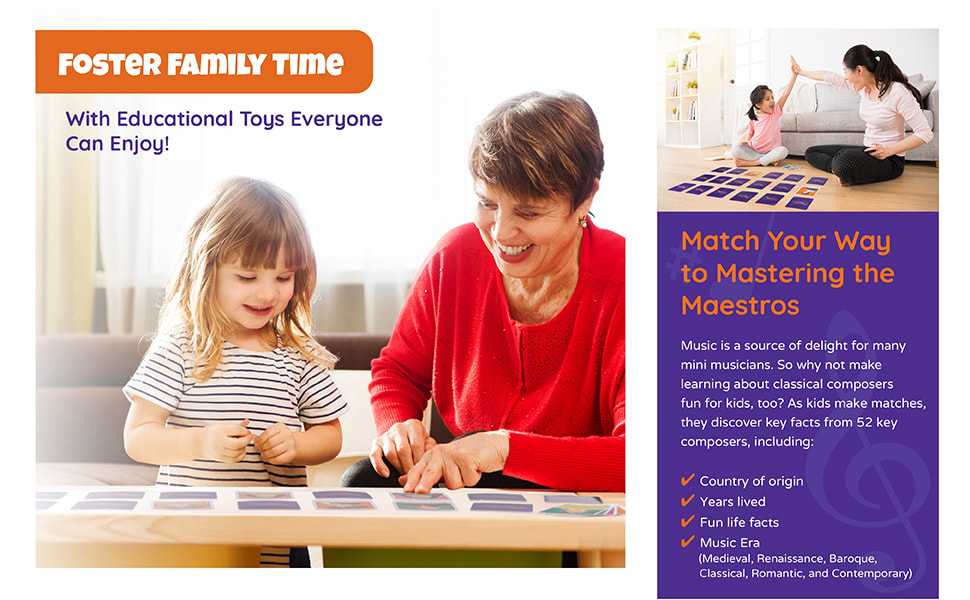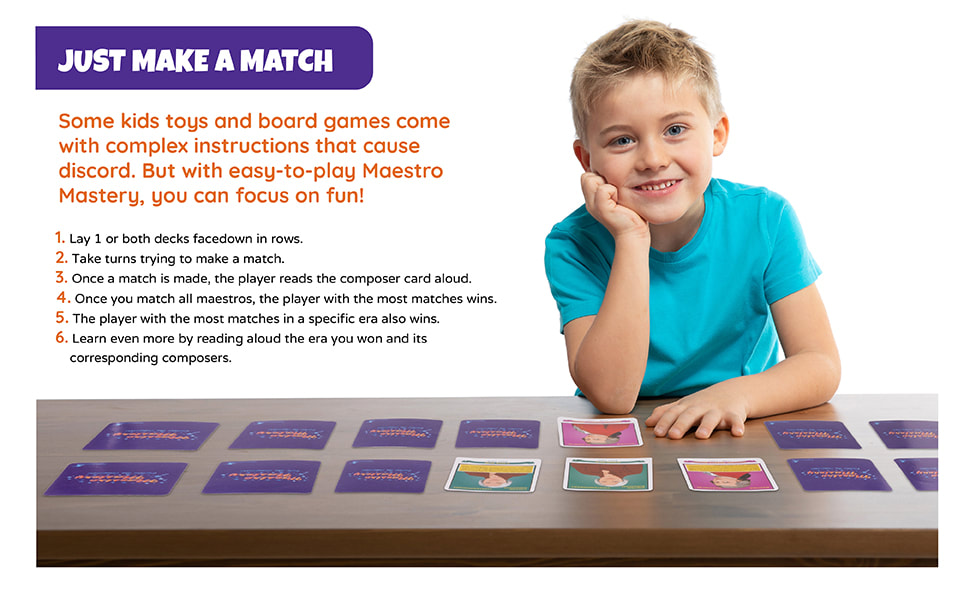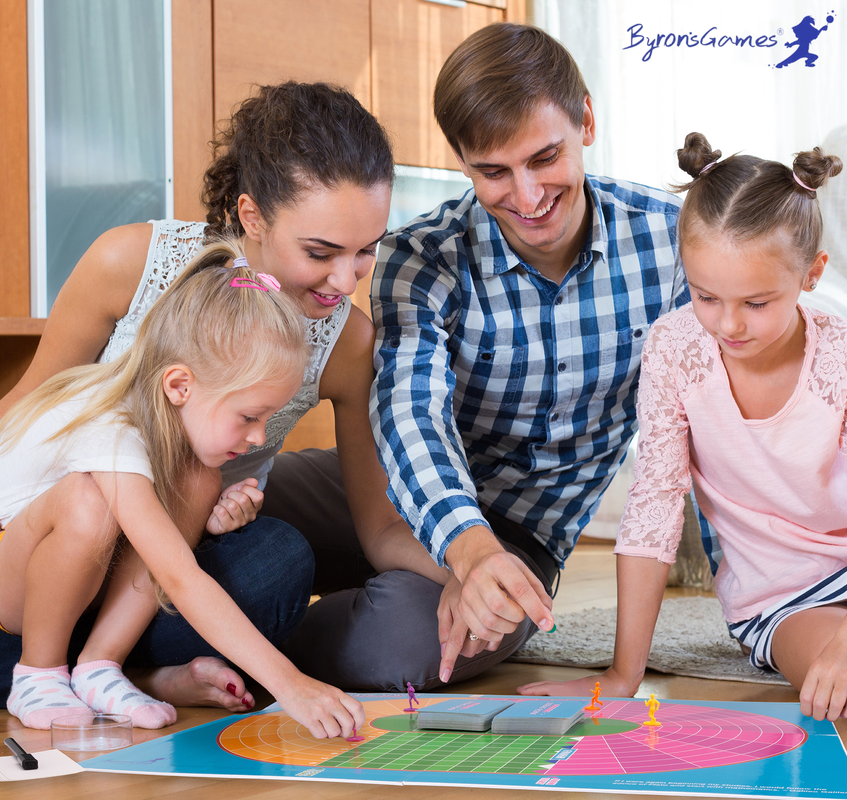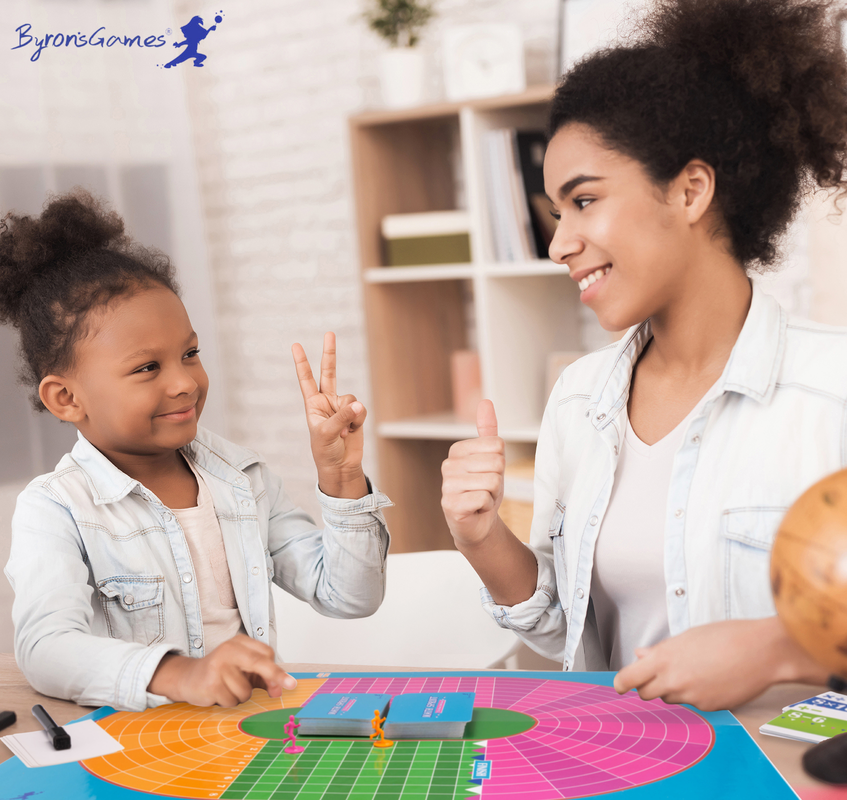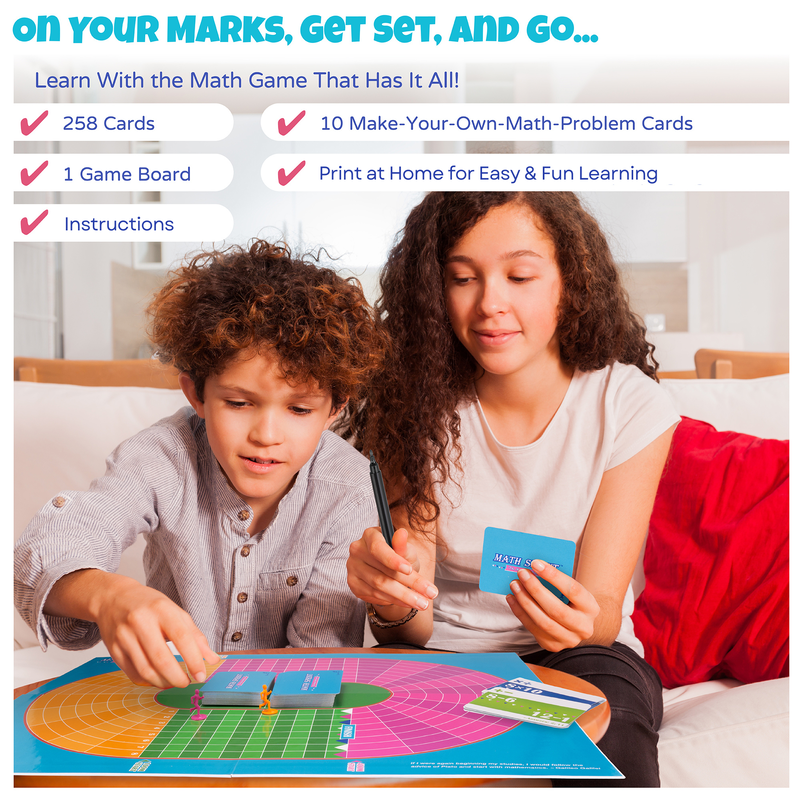|
Whether your little one is a budding Tiger Woods or just likes to hit a few balls around the backyard, this printable golf book for kids is sure to get them excited about this historic game! Golf: A Learn and Explore Adventure eBook from Byron’s Games is an easy-to-read and colorful experience that gives you the perfect way to introduce your child to the exciting world of golf. So put on their favorite golf hat and break out the clubs because it’s about to be tee time for your kiddo! Read to Inspire!It’s no surprise that kids are extremely receptive to their parent's voices. Studies even show that during the third trimester of pregnancy, an infant can already recognize his or her mother’s voice (source). Then, within the first two months of life, babies become more familiar with the voices of other family members. This is one of the earliest learning stages of child development and a big reason why reading aloud to children is so crucial for their growth. Of course, a child’s development starts at home and the earliest teachers are their parents. Talking to your children, singing songs with them, or reading them stories has a plethora of benefits, including:
This is why it’s important to spark your children’s interest in books as early as you can. Plus, reading aloud to young children can help them adjust faster when they start school. Additionally, reading books with kids can foster ideas, curiosity, and understanding. Children’s books like Byron’s Games’ Golf: A Learn and Explore Adventure eBook can even help get them interested in outdoor activities and sports! Benefits of Golf for KidsSimilarly, physical activity is very important when it comes to helping your children grow up healthy and strong. As early as possible, kids need physical activities to help them develop crucial skills, such as hand-eye coordination, strength, and stamina. It's also a great way for them to socialize and make new friends. Golf is one such activity that kids of all ages as well as their parents can enjoy. While some people may see golf as a boring sport, there are actually many benefits that kids can gain from playing golf. If you're looking for a healthy activity for your child to try, consider signing them up for golf lessons. Who knows, they might just have a natural talent for it! Here are some of the benefits of one of the greatest games your kids can play: 1. Golf Can Be Played by Children, Even at a Young AgeUnlike other sports, many coaches teach golf to children as early as five years old. Plus, kids as early as three years old can even learn to play, especially if they show an interest in the sport. You can introduce the sport by letting them watch you play on a golf course, watching golf tournaments on TV, playing a short game of mini golf with you, or even reading a golf book for kids with them, such as Golf: A Learn and Explore Adventure eBook by Byron’s Games! In fact, many pro golfers started at an early age. Who knows? Maybe your junior golfer will move on to become a pro player one day! 2. Golf Promotes Physical FitnessLike we mentioned above, physical activity is crucial for developing children. Playing golf is a great way to help your kiddo get more exercise and it can help strengthen the core muscles and spine as well as improve balance. Plus, since golf only provides a low-intensity workout, it won’t physically overload a child’s developing body. 3. Golf is a No-Contact SportUnlike other kids’ games that involve physical contact like basketball or football, golf is a non-contact sport that presents a lower risk of injuries. Still, it’s important to always stretch first before playing any sport, even golf! 4. Golf Can Foster Social SkillsThough the sport can be played alone, a good golf game can also be played in teams. This makes it easy to improve your family bonding experience by playing golf with your kids. Letting them play with other kids also encourages team spirit and healthy competition, plus it helps your child start to build lasting relationships at an early age. 5. Golf Gets Your Kids to Appreciate NatureLet your kids experience nature on an open golf course. Most golf courses have beautiful landscapes and a country club that can help your kids feel relaxed. With a casual round of golf, you can give your child the fresh air and sunlight they need while also playing an enjoyable game! Not to mention, this is a great way to help avoid your child spending too much time playing video games or watching tv. 6. Golf Instills Honesty, Patience, and DisciplineBecause golf has many rules, it helps teach kids to follow the rules, which then promotes discipline. Of course, it’s easy enough to move the ball or adjust the score when nobody’s looking, which is why teaching your children to play golf the right way can foster honesty and integrity. And since it’s a slow-paced game, players often need to wait patiently for their turn. These are lifelong skills that can be translated into all aspects of your child’s life. 7. Golf Helps Control EmotionsLike in any sport, it’s natural for a child to want to throw a tantrum when something doesn’t go their way, even while playing golf. However, teaching your child to overcome the inevitable mistakes and obstacles with a cool head will lead to them not only being a better player, but also to being able to manage their emotions better independently. It’s no secret that consistent self-improvement will help your kid become a major winner in life! 8. Golf Develops Analytical SkillsAnalytical and problem-solving skills are important in both school and life. Golf players often need to calculate their swing in order to land the ball as close to the hole as possible. They also have to learn how to observe carefully and think several steps ahead to land the perfect shot. It may not seem like it at first, but these skills will translate to better academic performance for your kiddo and later, they might even come in handy with business transactions, too! An Insight into this Printable Golf Book for KidsGolf: A Learn and Explore Adventure eBook is unlike all the other picture books you’ve seen around. It’s a sweet story about a boy teaching his baby sister how to play golf for the first time. Between enthralling lessons and hilarious mishaps, the children learn that everyone is valuable to the game—no matter how young! Plus, this storybook about golfing is filled with colorful illustrations that inspire curiosity, activity, and a love of togetherness. Made by Byron’s Games for kids ages 3+, it truly is the best book to introduce your child to the wonderful world of golf. Especially considering that it was made for kids, by a kid! At only six years old, Byron created a game called Continent Race during a month-long stay at Ann and Robert H. Lurie Children’s Hospital in Chicago. This began the journey of Byron’s Games, which seeks to give children creative outlets so they can flourish into curious, compassionate, and connected people. With beautiful quality, this digital copy of Golf: A Learn and Explore Adventure eBook allows golfing and non-golfing families alike to grow closer together through reading and playing. It also enables older children to independently explore their interests and gain a new appreciation for their sport. Plus, it encourages an activity that improves motor skills, coordination, manners, and more! Whether your child is an avid golfer or they know nothing about the sport, this printable storybook is sure to spark their interest! ConclusionAs you can see, golf is an exciting and super beneficial game to play with your children. If you're looking for a way to get your kids outdoors and enjoy some quality time together, look no further than golf!
This sport is great for all ages and it provides plenty of opportunities for learning and exploration. Of course, this digital copy of Golf: A Learn and Explore Adventure eBook makes it easy to get started, plus it allows families to read together and play together. Click here to download your own copy today!
0 Comments
Golf is a sport that can be enjoyed by people of all ages. It's a great way to get some exercise and fresh air, and it can also be quite relaxing. For kids, golf can also be a great way to learn about focus and hand-eye coordination. Plus, it's just plain fun! Here are some interesting golf facts for kids that your kiddos are sure to enjoy. Who knows, you might even learn something yourself! Plus, learning about this historic sport will make it even more enjoyable for your little golfers. And, when you’re done with this list, be sure to check out the downloadable ebook, The History of Golf & Other Interesting Facts from Byron’s Games for even more golfing fun! So grab your clubs and let’s get started! Short History of GolfDo you know the history of golf? Believe it or not, this really fun sport dates all the way back to the 15th century! Of course, golf is played on an open field with a series of holes on the ground. The player’s objective is to play their ball into a hole using strokes with golf clubs, the main instruments used in this centuries-old sport. At the end of this game, the player with the lowest number of strokes to sink the ball in the hole wins. While you probably already knew the basics of how the game of golf is played, you might not have known that this sport has its roots in ancient Rome and China. Interestingly, ancient Romans used to play golf using a ball made of feathers and branches. The early Chinese had similar games that used a ball and a target. Also, the Dutch used to play a similar version of golf consisting of sticks used to hit a leather ball into a target. While there are many traces of golf-like games throughout history, it was the Scots that really “putt” golf into the history books. In fact, golf as we know it today has been traced all the way back to the mid-1400s in Scotland. From there, it spread throughout the world. Fun Golf Facts for KidsFor many kids, golf may seem like a boring game for old people. But there are actually lots of interesting things about golf that can make it fun for kids to learn and play. Here are some of our favorite fun golf facts for kids that they may not know. Whether you already have a little golfer in the making or you’re hoping to spark interest in a new sport, your kids will love learning these fascinating fun facts! The Greatest Golfer of All TimeDid you know that Jack Nicklaus, nicknamed The Golden Bear, is pegged as the greatest golfer of all time? He won 117 pro tournaments, 18 major championships, and finished 73 PGA Tours. Compare that to another popular modern golfer, Tiger Woods, who has only won 15 major championships! The Youngest Golfer on the PGA TourBelieve it or not, Don Dunkelberger was only 11 years old when he became the youngest golfer to be invited to the PGA Tour during the 1937 Chicago open. Though he withdrew from the tournament after the opening round of 103, he’s still among the youngest to play the sport professionally. The First Golf BallsAccording to legend, the first golf balls were created when a bored shepherd hit a stone with his crook and the stone fell into a hole. Apparently, he wanted to repeat the success and decided to hit several more stones found around his sheep farm into the hole. However, since there’s no recorded history of this, many historians have assumed that the earliest golf balls were actually wooden or leather balls. The origins of golf are still debated, but it’s widely accepted that the “featherie,” or a leather pouch stuffed with feathers, was one of the first actual golf balls used in this game. The First Golf CourseWhile the early origins of this sport are highly debated, everyone can agree that the first documented game of golf was played on St. Andrews Old Course in Scotland in 1552. Since then, this course has become the standard-bearer for modern-day golf courses everywhere because of the 18-hole format. The Nine-Hole CourseDid you know that about 1/4 of the golf courses in the U.S. are only 9-hole courses? Also known as the “executive course,” a 9-hole course can be played once for a short game or twice for a full round of golf. Typically, the number of holes is only 18 or 9. If you hear the term “19th hole,” it’s most likely referring to something off the actual course, such as a clubhouse, pub, restaurant, or bar near the golf course. The Origin of the NameLinguistically, the word golf came from the Dutch word “kolf” or “kolve.” This word actually means club. It then became “goff” or “gouff” in the 14th or early 15th century before becoming known as “golf” in the 16th century. The First Hole-in-OneHere’s another interesting golf fact: The very first recorded hole-in-one was accomplished by Tom Morris in the 1868 British Open. Similarly, another fun fact is that the youngest golfer to record a hole-in-one was Jack Paine in 2001. Believe it or not, he was only 3 years old! It’s Tee TimeDo you know what Tee Time means? This clever golf term simply means the time that you are supposed to start the game. This phrase got its name from the stand where the golf ball sits before it’s hit by the club, otherwise known as a golf tee. Women GolfersOn January 9, 1811, the first round of women were recorded playing golf at the Musselburgh Golf Club in Scotland. It was Mary, Queen of Scots, who was the first woman to regularly play golf. In fact, it was also Mary who coined the term “caddy” because she called her assistants cadets. The Longest Golf CourseHave you heard of The Nullarbor Links? This golf course is the longest in the world at 850 miles long! This course is located along the southern coast of Australia, and a full round of golf here can take about five days to complete. Just imagine holding a golf tournament in this location! America’s First 18-Hole Golf CourseDid you know that the United States proudly celebrated 130 years of the first American 18-hole golf course in 2022? Downer’s Grove Golf Course in Illinois was established in 1892 and has delighted amateur and professional golfers alike over the years! The Longest DriveThe Long Drive is a game in golf where players compete to hit, or “drive,” a golf ball the farthest. Mike Austin holds the record for the longest drive according to the Guinness World Records. In 1974, Austin was able to hit a golf ball up to 471 meters or 515 yards in a tournament held at Winterwood Golf Course in Las Vegas. Learn More About Golf with Byron’s Games!Of course, there are so many more fun facts about this fascinating sport that we still haven’t covered! As one of the most popular outdoor sports in the world, it’s really no surprise that golf has endured through the centuries. Whether or not you have a golfing family, your children ages 3+ will love learning more about golf with the downloadable eBook, The History of Golf & Other Interesting Facts from Byron’s Games. This ebook about golf for kids also includes a sweet, sibling-focused story that teaches an important lesson about how everyone is valuable to the game, no matter how young! Plus, the educational section of this book will help your young ones learn a little bit of history while fueling their passion for golf and lifelong learning. With beautiful quality, this golf ebook explores topics such as:
Not only does this printable book for kids coax children away from screens, but it also inspires curiosity, activity, and a love of togetherness. ConclusionWe hope you enjoyed learning about this historic sport as much as we enjoyed gathering these fun golf facts for kids!
If you want to learn more or if you’re looking for a great opportunity for family bonding, be sure to check out the other incredible products from Byron’s Games. Many of the games and activities are easy to print out and take with you wherever you go for easy and fun learning, no matter where you are! Thanks for reading, and have fun hitting those balls down the green! Click here to download The History of Golf & Other Interesting Facts from Byron’s Games. If you're looking for a book that will get your kids excited about music, look no further than the Maestro Mastery eBook! This printable children’s book will help you nurture your child’s musical genius with photos & biographies of famous composers for kids. This digital copy of Maestro Mastery is the perfect way to inspire your child’s love of music. Your children ages 5+ will love learning about these fascinating music pioneers and their amazing achievements with this exciting and informative picture book. Plus, it even includes links to listen to samples of the famous works from these great composers! The Value of Classical Music for KidsIntroducing classical music to kids of all ages is a fantastic way for them not only to develop their musical skills, but also to learn about music history. The benefits are numerous when it comes down to how this impacts child development. From improved concentration levels to increased creativity, there are many reasons to introduce the little ones in your life to classical music. In fact, research shows that young children listening to classical music feel more relaxed and calm than before listening to it (source). Another study showed that children who undergo musical training tend to develop a better verbal memory and reading ability than children who don’t (source). With so many advantages to learning about and listening to classical music, it’s no surprise that so many music teachers, parents, and homeschoolers have loved reading the Maestro Mastery eBook with their children! Let’s explore some of the other benefits of classical music for children: 1. Improves SleepListening to classical music before bedtime is a great way to help your little one get a more restful night's sleep! In fact, researchers at the Sleep Foundation say that listening to 45 minutes of soothing classical tunes can help children of all ages, from babies to elementary school children, sleep better at night (source). 2. Better ConcentrationNot surprisingly, classical music has also been found to help elementary school children with ADHD concentrate better (source). Aside from concentration, classical tunes also appear to help with speech, language, and motor skills in young children. 3. Reduces Blood PressureA study conducted at Oxford University found that some classical music was effective in lowering the participants’ blood pressure, while the other genres studied either had no effect or actually contributed to an increase in blood pressure (source). This has led to the theory that classical music might also help in treating heart disease for kids, when used as an additional therapy alongside other treatments. 4. Suppresses StressOf course, classical music has been shown to have a calming effect on the heart, making it perfect for stress relief. In one study, this effect was even evident in children's movies and cartoons that use classical pieces as background noise (source). Even pregnant women who listen to classical music are reported to feel less stressed! 5. Increases ProductivityPlaying classical music for kids has also been found to make their reading more enjoyable. Likewise, it also tends to improve the quality of work that they do. This is because classical music creates a sense of relaxation which helps them focus on tasks for longer periods. One study even found this to be true for ADHD children (source). 6. Helps Relieve PainIt turns out that listening to classical music can even help kids with pain relief, especially with headaches! In fact, a research study showed that music therapy is extremely calming and soothing for hospitalized children and teens, and that it has a significant effect on their pain reduction (source). Fun Facts About a Few of These Brilliant Composers for KidsLet’s take a look at some of the great composers of classical music throughout the ages that are featured in the Maestro Mastery eBook. The stories of these musicians will surely inspire your child prodigy! 1. Ludwig van BeethovenBeethoven's music is so powerful and expressive that it can move people in a way no other composer has been able to match. Essentially, he translated emotions into music. Beethoven was among the child prodigies of his generation who first publicly performed at age 8. His most famous works include Symphony No. 5 in C Minor, Op 67 (1808), Symphony No. 7 in A Major, Op 92 (1813), and Symphony No. 9 in D Minor, Op 125 (1824). 2. Johann Sebastian BachRegarded as the most accomplished organist and harpsichordist of the Baroque era, J. S. Bach wasn’t widely known until after his death. However, the diversity of Bach's music is unparalleled. From large orchestral and choral settings to chamber pieces for various combinations or solo instruments, he truly wrote it all! Bach’s most famous works include Brandenburg Concerto No. 3 in G Major, Goldberg Variations, and Concerto for Two Violins in D Minor. 3. Antonio VivaldiVivaldi was a brilliant composer and a strong influence on Bach. So strong, in fact, that Bach transcribed 10 of Vivaldi’s works for keyboard instruments. Also, being a priest, Vivaldi was a prolific composer of choral and sacred music. His most famous works include Four Seasons, L’estro Armonico Op. 3, Concerto No. 10 in B Minor, and Flute Concerto La Notte. 4. Francesca CacciniShe was the first woman to compose opera and one of the most well-paid musicians in court at the peak of her career. Francesca Caccini, one of the more famous women composers, grew up with a love for music surrounded by Florence's finest artistic residents—the famed Medici family. Her most famous works include Il Primo Libro delle Musiche a una e due Voci and La Liberazione di Ruggiero dall’isola d’Alcina. 5. Wolfgang Amadeus MozartRemarkably, Wolfgang Mozart composed more than 600 pieces in his short lifetime! This prolific musician, along with his sister Maria Ana, were child prodigies. At only age 5, he began to compose and even publicly performed. His most famous works include The Magic Flute, the unfinished Requiem, and Symphony No. 41 in C Major, K. 551, nicknamed the Jupiter Symphony. 6. Florence PriceWhen the Chicago Symphony Orchestra performed a new piece by an unknown composer on June 15, 1933, it caused quite a sensation. The music critic for Chicago's Daily News declared that "this faultless work speaks its message with restraint and yet manages to convey passion." The unknown composer was Florence Price, the first black female composer to have her work performed by a major orchestra! Her most famous works include Symphony No. 1, Piano Sonata in E Minor, and Violin Concerto No. 2. 7. Pyotr Ilyich TchaikovskyMost classical music lovers are probably familiar with Tchaikovsky. His famous compositions are tuneful and picturesque. He could evoke emotion with his open-hearted melodies that make you want to dance in the street or sit down for a lovely afternoon tea. His most famous works include Swan Lake, Dance of the Sugar Plum Fairies from The Nutcracker, and 1812 Overture. Make Learning Fun with the Maestro Mastery™ eBookOf course, there are so many more incredible maestros to learn about and great masterworks of music that are worth listening to! The Maestro Mastery eBook from Byron’s Games makes it easy for you and your kiddos to discover a world of passion, genius, and sound, from the timeless tones of the Medieval Era to the modern melodies of today. Music has the power to evoke emotions, improve mental and physical health, and so much more. Plus, your child will have so much fun discovering the inspiring stories of the 52 musical legends featured in this music composers book for kids! This classical music education book also includes the time period of each composer, so your kids can also learn a little bit of history through music. Coupled with the Maestro Mastery Memory Game, this printable eBook will be your young virtuoso’s go-to guide for beginning their musical careers! ConclusionIf you have a young music lover in your life, or if you’re just looking for an exciting way to learn more about classical composers, download a copy of the most exciting book about music composers for kids—the Maestro Mastery eBook! Not only is it packed with fascinating facts, inspiring quotes, and immersive videos, but it also has beautiful illustrations that will capture the imaginations of children and adults alike. And when you’re ready for even more musical fun, don’t forget to check out our companion classical composers music game, the Maestro Mastery Memory Game from Byron’s Games! References:As a family, it’s important to find ways to connect and communicate with each other. One great way to do this is by keeping a journal together. Fortunately, The Family Journal eBook from Byron’s Games is the perfect resource to help your family flourish! This digital and printable journal provides prompts and ideas for families of all shapes and sizes to get creative and have some fun while recording memories and building connections. Whether you’re just starting out as a family or you’ve been together for many years, this journal is sure to help you thrive! Why Download The Family Journal eBook?
Did you know that spending time as a family has many benefits? In fact, many studies have shown that when families spend more quality time together, children are typically more successful overall.
One research study found that when parents are able to communicate with their kids effectively, the child is more likely to have more self confidence and perform better academically than children who don’t have quality parent-child communication (source). Of course, parents always want what’s best for their children, whether that’s academically or socially. The Family Journal eBook was designed to help parents plan and facilitate weekly meetings with their children that will foster effective communication and strengthen relationships between parents and kids. From setting family goals and priorities to communicating better, there’s no doubt this resource will help you create lasting memories together. What Does This Family Planner Book Include?
With this undated, 12-month weekly planner, you’ll find it much easier to connect with your family on a weekly basis while supporting and inspiring one another. Plus, when difficult conversations arise, writing down thoughts in this family journal is an excellent way to support each other and promote communication that feels safe for everyone.
This easy-to-use, printable tool includes powerful prompts that will facilitate valuable and deep discussions on topics such as creating a family mission statement, yearly goals, monthly planning, and weekly meetings. This allows families to align viewpoints and create a shared vision together. It also contains fun family activities designed to create a climate for closeness, as well as influential quotes for reflection and inspiration. The Family Journal eBook is super easy to print at home, plus it includes 12 full months of activities that will bring your family mindfulness, connection, and commitment. That’s 4x the time of most other gratitude journals! Additionally, because this journal is in ebook format, it’s easy to reference on-the-go or to print over and over again for years to come! More Family Fun
Aside from the printable Family Journal eBook, Byron’s Games has a whole list of fun products that the whole family can enjoy—especially the kids!
Here’s some of our family favorites: Continent Race®
This award-winning game introduces your children to the world of geography. It features the national flags of the world’s countries with maps, mystery cards, and wild cards. Your kids will love this fast-paced learning game that’s challenging for both kids and adults alike! Click here to buy on Amazon.
Math Sprint® - The Print-at-Home Mental Math Game
Let your kids learn to love math while bonding over a game of Math Sprint! It’s so easy to play and fun for kids of all ages over 7, thanks to the ability to personalize your game to the players’ skill level. Plus, since this board game is a digital download, you can print your Math Sprint kids game as many times as you'd like to keep adding fun to learning over and over again! Click here to buy from Byron’s Games.
Maestro Mastery™ - The Print-at-Home Music Memory Game
Learning music history is a total blast with Maestro Mastery! Grab your child’s attention with classical music from different eras and let them learn about the masters of the craft while having fun with their friends. Plus, don’t forget to add in the Maestro Mastery eBook so they can get a look at how these masters came to be! Click here to buy this award-winning memory card game from Byron’s Games.
Golf: A Learn & Explore Adventure eBook
Inspire the little ones in your life to ditch the screens and get moving by reading this sweet, sibling-focused story about golfing. This eBook is great for helping children explore their interests and gain a new appreciation for their sport. Click here to buy from Bryon’s Games.
100 Kids Books Poster (Print-at-Home)
Help your kids get passionate about reading with this interactive and inspiring digital download! This poster lists incredible book ideas that you can read together with your child, encouraging them to explore authors that might be their favorites one day! Whether it's an early reader or a chapter book, with every sticker or check mark added to this poster comes a great sense of achievement. Click here to buy from Byron’s Games.
Get Inspired with Byron’s Games®!
Did you know that Byron’s Games was created for kids, by a kid?! Believe it or not, Byron was only 6 years old when he first got the idea to develop Continent Race during a month-long stay at Ann and Robert H. Lurie Children’s Hospital in Chicago.
The inspiration came when Byron was challenged to keep track of the medal counts for each country during the 2016 Summer Olympic Games. When the Olympics ended, Byron was challenged to create a new game using flags, and thus, Continent Race was born! He immediately realized that he wanted other hospitalized children to have access to this game so they could play something fun AND learn while they recovered. Since then, Byron’s Games has donated over 25,000 games to non-profit organizations around the nation! This game not only changed Byron’s life, but also the lives of thousands of children in hospitals across the United States. Conclusion
If you're looking for a way to get organized and connect with your family, look no further than Byron’s Games! The Family Journal eBook is the perfect way to stay connected with those who matter most to you, no matter what your unique family dynamics look like.
This custom planner works has everything you need to keep your family inspired, connected, and even entertained. Click here to download The Family Journal eBook and start strengthening your familial bond today! References:Do you have a little Mozart or Beethoven in the making at home? If so, we’ve got the perfect printable music memory game for kids that your little maestro will simply adore! This fun matching game is not only educational, but it can also help improve your child’s memory skills, too. Plus, playing this game with siblings or friends is a total blast! So, what are you waiting for? Click here to download this print-at-home matching game and see how much your child’s long-term and short-term memory improves! What is the Maestro Mastery™ Memory Game?
It’s no secret that educational games can help a child develop key skills while having fun. That’s why the Maestro Mastery Memory Game is the perfect gift for kids ages five and above.
Maestro Mastery isn’t just any print-at-home memory card game—it actually allows children to learn about 52 of the greatest composers and their musical timelines! In fact, this game is so helpful that the Tillywig Toy Awards of 2021 crowned this memory card game with the highly coveted Brain Child Award! Here's what they have to say about the game: “This exceptionally fun memory matching game exposes children to a wealth of information about famous classical composers and their lasting contributions. As a parent, it is quite gratifying to hear youngsters excitedly discussing Mozart, Rachmaninoff, Ravel and numerous other giants of our musical heritage. Maestro Mastery's 104 matching composer cards feature 52 composers, with every card displaying the composer's portrait, country of origin, the musical era in which they were active, and dates of birth and death. One of each pair also contains details about the composer, facts so fascinating they tend to stick with players long after play is over. The color-coded cards make it easy for young kids to group matches by era, an important feature since players with the most matches from a given era are honored alongside the player with the greatest number of overall matches. A music timeline card lists the names and date ranges for each of the eras (Renaissance, Baroque, etc.) and highlights distinguishing characteristics of that era's music, while a large included wall poster allows kids to easily explore all 52 composers!” How Do You Play This Memory Game for Kids?
Luckily, Maestro Mastery is simple and easy to play. This matching card game starts with at least two players, but the whole family can join in for the musical fun!
Just place the cards facedown, then the first player chooses two cards and attempts to match the composer with the facts about them. Next, the second player does the same, and so on. When a match is made, the player reads the composer card aloud and keeps the pair. After all maestros have been matched, the player with the most matches wins. Plus, the player with the most matches in a specific era wins, too! Older kids and even adults will also enjoy playing this game because it equips everyone with a musical knowledge that might not have been learned in school. The key facts kids will learn about each composer with this game are the maestro’s country of origin, years lived, fun life facts, and the music era the composer belongs to. For just $8.99, you’ll get access to the entire digital collection of this Maestro Mastery game, which you can print an unlimited amount of times! This collection includes 2 card decks with 52 composer cards total, a musical timeline board for children to learn the different music eras from medieval to contemporary, instructions that explain how to play, and a poster of 52 of the greatest musical composers of all time, all of which are featured in the game. You can even choose to have this fun game printed at a specialty print shop to enjoy different sizes of the cards and posters, or choose to print it on thick card stock at home. Plus, this game comes with an exciting bonus! On the included instructions, you’ll find the link to an online companion tool that allows you to enjoy listening to a sample of each featured composer’s work. Listening to classical music has been shown to help improve memory, mental alertness, and even your mood. These sample music selections with the maestros’ masterful creations are sure to enhance your learning fun! Add in the Maestro Mastery™ eBook!
To further your child’s musical knowledge, you’ll love adding in the Maestro Mastery eBook! This digital and printable book allows kids to explore more about the lives and works of the 52 classical music composers featured in the Maestro Mastery game, from the timeless tones of the Medieval Era to the modern melodies of today.
Packed with fascinating facts and immersive videos, your learning ebook for kids will deepen your young virtuoso’s knowledge and appreciation of music history and its masters! Of course, it’s no secret that children are curious beings who seem to have a never-ending thirst to learn and explore. Byron’s Games makes it possible for them to do so while fostering creativity in your kiddos. With Maestro Mastery, we’re providing the tools that allow school children to learn about and even listen to great music! Both older and younger children alike will love playing the Maestro Mastery matching game and reading the accompanying Maestro Mastery ebook. This brilliant duo from Byron’s Games is sure to inspire any young musician. More About Byron’s Games
Of all the printable and online memory games out there, you can be sure that Maestro Mastery will be a major hit with your kids. In fact, all of our games at Byron’s Games have been specially designed for kids, by a kid!
Our founder Byron was only 6 years old when he found himself stuck in a hospital for a month due to an unexpected illness. During his hospital stay, his love of geography and desire to help other hospitalized children inspired him to create our first game, Continent Race®. Since then, Byron’s Games has continued to create fun and educational games, including the Maestro Mastery Memory Game! Plus, we love giving back at Bryon's Games. That's why we recently donated over 25,000 games to non-profits around the United States! Conclusion
If you're looking for a fun and educational game to help your little one learn music history, look no further than the Maestro Mastery printable music memory game! This game is perfect for younger and older children alike and it can be played over and over again for endless fun.
Plus, it's really easy to make at home. Simply download the printables from the purchase page on our website, print, and play. Click here to play today! If you're looking for a fun way to help your kids brush up on their math skills, look no further than the print-at-home version of Math Sprint from Byron’s Games! This printable math game is perfect for kids ages 7+ and can be played with groups of 2-8 people. With a few simple rules and some basic math skills, your kids will be racing to solve problems and complete challenges in no time! Get ready for some serious learning fun with this informative game. Math has never been so exciting than with the print-at-home version of Math Sprint! What is the Math Sprint® Game?
To build a solid foundation for your child, it’s important to let them participate in hands-on activities that are not only educational, but also fun!
Not surprisingly, some elementary students struggle with math because they find it confusing. This is why teachers often try to think of fun math activities to engage younger kids. If you have a child in your life who has a difficult time learning math, don’t worry! This is where Math Sprint comes in. Whether your child already enjoys math or they find it hard to understand, math problems are always exciting for kids while playing this mental math game! Of all the variety of educational games available online, this game will surely make math fun for your kids as well as the rest of the family. It teaches your children math problems like basic addition, subtraction, multiplication, and division. It even helps them start early with math word problems! How Do You Play?
Math Sprint is best for young children ages 7 years old and above, and it actually grows with your child! The difficulty level can be adjusted to your kiddo’s skill level thanks to 3 race lengths and beginner to advanced level cards. This ensures that the game develops their problem solving skills while making sure they still have fun, no matter what their current skill level is with math. Basically, this game is the best way to help your children tackle arithmetic at a young age!
Plus, at Byron’s Games, we think it’s best to leave the complex rules for calculus. That’s why the rules for Math Sprint are easy and fun. Finish first simply by advancing your player each time you successfully solve a subtraction, addition, multiplication, division, or word problem. Then, once a player lands on the finish line, they can choose to play at a more difficult level. You can have as many as eight players racing toward the finish line together, making Math Sprint a wonderful addition to game night with friends or family. So gather all of your kid’s friends and siblings and get ready to make learning fun! This exciting board game will not only replace the old and boring flashcards, but it’ll also develop your child’s love of math. What Comes With This Printable Math Game?
The print-at-home version of this game from Byron’s Games comes with 258 game cards, a game board, instructions, and 10 customizable, make-your-own-math-problem cards.
You can use playing pieces from any game to run around the board, or get creative and make your own players! And, since it’s a digital download, you can print the game board at home or choose to send the file to a specialty print shop for a larger version of the track. Either way, this fun game is sure to give your child lots of practice mastering math while enjoying family time! Why Choose Math Sprint® by Byron’s Games?
Of all the math board games or printable games online, Math Sprint is truly one of a kind. Each of Byron’s Games have been created for kids, by a kid!
At only six years old, Byron found himself in the middle of a month-long stay at Ann and Robert H. Lurie Children’s Hospital of Chicago. During this stay, Byron received much more than treatment for an unexpected illness. In fact, he received something else entirely: The inspiration to help kids just like him learn and have fun during their hospital stays and beyond. Byron’s first game, Continent Race®, turned out to be such a success that he was able to donate games to 130 children’s hospitals nationwide! But the love didn’t stop there. Byron’s Games has continued to channel Byron’s fun and creative spirit and ideas into everything we do. Recently, we donated over 25,000 games to non-profits across the country! This means that your purchase of Math Sprint has the potential to help not only your children, but also other children, too! Conclusion
Who says math can’t be fun? If you’re looking for an interactive math game, look no further than Math Sprint!
This printable game is perfect for kids ages 7+ and can be played with a partner or in a group setting. Having a strong foundation in math is fundamental to school and subsequent success, and it’s important that your kiddo is on the right math path. After all, when kids struggle to understand mathematics, those struggles often subtract confidence and comprehension while adding confusion and concern. It’s time to help your child strengthen their knowledge and self-assurance, helping them lead their race to academic, career, and life success. Ready, set, learn–with Math Sprint! Click here to start playing today!
Olympics in Rio de Janeiro, Brazil. Byron created the game Continent Race at age 6, during a month-long stay at Ann and Robert H. Lurie Children's Hospital in Chicago. Byron enjoyed helping Mrs. Ellen Donovan, of the Family Life Center, keep track of country medal counts during the 2016 Summer Olympic Games. Once the games ended, "Ms. Ellen" challenged Byron to create a game using flags. Byron took the challenge and ran with it! When he began creating the game, he immediately decided he wanted to create it for children in the hospital, so that they could play something fun AND learn while they recovered.
Byron started out helping keep track of medals won and identifying world flags. That lead to matching the flags to a map of the world, which quickly developed into our game Continent Race! You can keep track of medals won in this year's Olympics by clicking here. We also have a fantastic Olympics sale going on over at Amazon. Right now, the game is 12% off, but you can save an additional 11% through the end of the Olympics now through August 8th by clicking on the coupon in Amazon. That's a total of 23% savings! This also includes Prime One-Day shipping, so your family can use the game to create your own Olympics medal chart at home before the closing ceremony. We hope you all enjoy the Olympics as a family and may we all watch athletes around the world strive for greatness with the new motto, "Faster, Higher, Stronger - Together." There’s something particularly satisfying about solving a math problem in a non-traditional way. Although some schools teach that there are various ways to get to the right answer to a math problem, other schools may want every student to use a standard method to add, subtract, multiply, and divide.
Whether your kids are taught a variety of methods or one standard method for each type of problem, when they’re doing their homework - or if you’re homeschooling - there are plenty of math tricks for kids you can teach at home. Many of us associate the word fluency with language. Children become fluent in the language spoken in their home, quickly picking up the ability to speak and understand it. Kids who start to learn a second language at an early age are likely to become fluent more easily than those who start when they’re older, but that doesn’t mean older kids can’t become fluent in a second language. The same is true for math fluency.
If you’re wondering about the importance of math fluency for kids, you should know that the earlier you start math fluency practice with them the better, but even older kids can gain mathematical fluency - especially if you make it fun. You’ve probably used inspirational quotes to teach your kids values that you’d like them to embrace. Or, maybe you’ve had your kids repeat quotes as affirmations to build up their confidence. But, have you ever thought about using math quotes for kids to encourage them to embrace why math is important or help them remember some math facts? It might not be the first thing you think of when reinforcing math skills, but using math sayings for kids can be another method you can use to make math fun. One great thing about math quotes for kids that inspire is that they can lead to additional conversations about math. Understanding some funny math quotes may take some explanation about the mathematical terms used in them. Kids may remember basic math definitions based on the funny math sayings or positive math quotes you teach them. If you teach your kids famous math quotes, or at least math quotes said by famous people, you can also get a little biography and history in, too. For example, there’s a math quote below by Paul Harvey. If your child doesn’t know who Paul Harvey was, you can talk about who he was, maybe even getting into a discussion about the importance of radio announcers way back when. Who knows where these math quotes for kids may lead you. Check out our other math for kids posts: |


